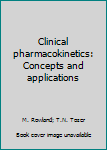Clinical pharmacokinetics: Concepts and applications
Since pharmacokinetics can greatly affect how different patients respond to the same drug, both students and physicians need a basic clinical understanding of this vital area. The Third Edition of Clinical Pharmacokinetics provides a practical perspective, with these added features considerations of both stereochemistry and the increasing number of polypeptide and protein drugs being developed; the range and number of problems at the end of each chapter...
Format:Hardcover
Language:English
ISBN:0812106814
ISBN13:9780812106817
Release Date:January 1980
Publisher:Lippincott Williams and Wilkins
Length:331 Pages
Weight:2.00 lbs.
Customer Reviews
5 ratings
Gets me through class
Published by Thriftbooks.com User , 15 years ago
Can't say I like the information in the book, but the book itself is very beneficial.
The Bible of Pharmcokinetics
Published by Thriftbooks.com User , 15 years ago
"Clinical Pharmacokinetics: Concepts and Applications" (or better known as Rowland and Tozer) is a book filled with deep concepts and good explanations. It is the Bible of Pharmacokinetics. If there is a PK concept you want to look up, this book will be the first place you look for it. Before giving the review, let me introduce my background. I have a formal education in physical chemistry and analytical chemistry and am currently working in the field of pharma. I have currently read through half of this book. Although I have not completely finishing the book, I believe there is enough information to share. The previous PK book I read was Concepts In Clinical Pharmacokinetics by Joseph T. Dipiro and it is a shorter and simpler book than Rowland and Tozer. While "Concepts In Clinical Pharmacokinetics" was a delight to read, it is on the simpler side and a lot of concepts are left unexplained. When I was reading it, there were often moment of "How did he get from this to that?" or "Where this comes from?", and I had to stop reading and tried to derive the equations. In contrast, Rowland and Tozer explain the principles of PK in great details and often from multiple angles, so that the readers can fully appreciate how the concepts are linked together, how PK theories apply and how PK impacts pharmacology research and the drug discovery. The exercises are challenging, but not impossible. Well, a few of them are nearly impossible, but most of them can be worked out (even for someone of my background). I would love to give it a 4.5 stars, but that is not an option. I do see there are a few shortcomings in this book. Although it is very detailed, it can be too detailed for beginners, except for students who has more time. It is best to start off with a short and easy to read introductory book. Yes, Rowland and Tozer have explained many concepts in multiple ways and this is generally good, except when you are busy. Sometime, I just feel like: I get your point already. The Final and the real criticism is that the book can be a bit dry. Unlike "Concepts In Clinical Pharmacokinetics", this is not a book to be breezed through.
Best reference on PK
Published by Thriftbooks.com User , 16 years ago
This excellent book (1980 edition) was my introduction to this topic. I have it in my bookshelf and I keep referring back to it. Without planning it, I've become the resident PK expert in my department thanks to this reference! Thank you Drs. Rowland and Tozer.
Great book, the gold standard intro
Published by Thriftbooks.com User , 21 years ago
This book is a very finely crafted comprehensive introduction to pharmacokinetics, with enough pharmacodynamics to give one context. If you are new to PK/PD and need to understand and work with the subject matter this is an EXCELLENT starting point and a fine reference. The prose is clear, the organization thoughtful, and the figures and diagrams are masterful - best in class. The authors are both renowned academics with extensive industrial experience. That background shines through in the thoughtful way that topics are motivated and explained. I found the questions useful and thought-provoking. Isn't it the case that the more iron one pumps in the gym, the stronger one is on the playing field?One thing that I would add to this book (and most other PK books I've seen) would be a comprehensive listing of the different math models (one or two compartment, IV, or zero or first order input, etc), highlighting different uses (closed form solutions are easiest to use for parameter estimations, ODE formulations for repeat dosing, etc.) and their different parameterizations. This book contains some of this information (e.g. Table 19-1), but an appendix with this info would be useful. An additional improvement with great teaching utility might be an elementary modeling/estimation program for MS-Excel.For those needing an overview of PK (e.g. a pharma executive responsible for a development program) without a lot of the details necessary for practitioners, a less-comprehensive book that is also very good is Peter Welling's "Pharmacokinetics". Gabriellson's and Weiner's book "PK and PD Data Analysis" has a more spotty overview of the basic subject matter, but does have descriptions of many techniques not found elsewhere. The latter book is "WinNonLin-centric" (WinNonLin is a program written by one of the authors) which may be what is wanted.My favorite intro book and basic referencer for PK is definitely Rowland and Tozer. Bravo!
question
Published by Thriftbooks.com User , 25 years ago
Helo, I JUST WOULD LIKE TO ASK YOU IF THE LAST EDITION OF THIS BOOK IS AVAILABLE FOR READING FROM YOUR WEB SITE? I THANK YOU IN ADVANCE. ANNICK





